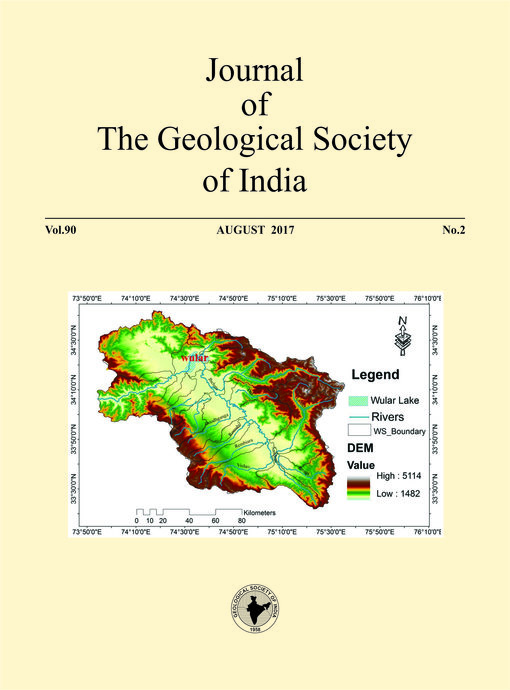Assessment of Uranium in Correlation with Physico-Chemical Properties of Drinking Water of Northern Rajasthan
DOI:
https://doi.org/10.1007/s12594-017-0704-xAbstract
In the present study, analysis of 238U concentration in 40 drinking water samples collected from different locations of Jodhpur, Nagaur, Bikaner and Jhunjhunu districts of Rajasthan, India has been carried out by using high resolution inductively coupled plasma mass spectroscopy (HR-ICP-MS) technique. The water samples were taken from hand pumps and tube wells having depths ranging from 50 to 800 feet. The measured uranium concentration lies in the range from 0.89 to 166.89 μg l-1 with the mean value of 31.72 μg l-1. The measured uranium content in twelve water samples was found to be higher than the safe limit of 30 μg l-1 as recommended by World Health Organization (WHO, 2011) and US Environmental Protection Agency (USEPA, 2011). Radiological risk calculated in the form of annual effective dose estimated from annual uranium intake ranges from 0.66 to 138.63 μSv y-1 with the mean value of 26.28 μSv y-1. The annual effective dose in two drinking water samples was found to be greater than WHO (2004) recommended level of 100 μSv y-1. Chemical risk calculated in the form of lifetime average daily dose (LAAD) estimated from the water samples varies from 0.02 to 4.57 μg kg-1 d-1 with the mean value of 0.87 μg kg-1 d-1. The lifetime average daily dose (LAAD) of ten drinking water samples was found to be greater than WHO (2011) recommended level of 1 μg kg-1 d-1. The corresponding values of hazard quotient of 48% water samples were found to be greater than unity. A good positive correlation of uranium concentration with total dissolved solids (TDS) and conductance has been observed. However no correlation of uranium concentration with pH was observed. The results revels that uranium concentration in drinking water samples of the study area can cause radiological and chemical threat to the inhabitants.Downloads
Metrics
Issue
Section
Downloads
Published
How to Cite
References
APHA (American Public Health Association). (1985) Standard methods for the examination of water and waste water. 16th edition, Washington, D.C.
Babu, M. N. S., Somashekar, R. K., Kumar, S. A., Shivanna, K., Krishnamurthy, V. and Eappen, K. P.(2008) Concentration of uranium levels in ground water. Internat. Jour. Environ. Sci. Tech., v.5(2), pp.263-266.
Balbudhe, Y., Srivastava, S. K., Vishwaprasad, K., Srivastava, G. K., Tripathi, R. M. and Puranik, V. D.(2011) Assessment of age dependent uranium intake due to drinking water in Hyderabad, India. Radiation Protection Dosimetry, v.148, pp.502-506.
Banks, D., Royset, O., Strand, T. and Skarphagen, H. (1995) Radioelement (U, Th, Rn) concentrations in Norwegian bedrock groundwaters. Environ. Geol., v.25, pp.165-180.
Davila Rangel, J. I., lopez del Rio, H., Mireles Garcia, F., Quirino Torres, L. L., Villalba, M. L., Colmenero Sujo, L. and Montero Cabrera, M. E. (2002) Radioactivity in bottled waters sold in Mexico. Appl. Radiat. Isot., v.56, pp.931-936.
Fisenne, I. M. and Welford, G. A. (1986) Natural U concentration in soft tissues and bone of New York City residents. Health Physics, v.50, pp.739-746.
Gedeon, R., Smith, B., Amro, H. and Jawadeh, J. (1994) Natural radioisotopes in groundwater from the Amman-Zarka basin Jordan. Hydrochemical and regulatory implications. Applications of tracers in arid zone hydrology. Wallingford, UK: IAHS Press. IAHS Publication 232.
ICRP (International Commission on Radiological Protection). (1991). Recommendations of the International Commission on Radiological Protection. Oxford: Pergamon Press; ICRP Publication 60; Ann ICRP 21 (1-3).
ICRP (International Commission on Radiological Protection). (1993). Protection against radon-222 at home and at work. Oxford: Pergamon Press; ICRP Publication 65; Ann ICRP 23(2).
ICRP (International Commission on Radiological Protection). (1996). Age dependent doses to the members of the public from intake of radionuclides part 5: compilation of ingestion and inhalation coefficients. Oxford: Pergamon Press; ICRP Publication 72; Ann ICRP 26/1.
Kumar Garg, V. and Singh, B. (2013) Fluoride signatures in groundwater and dental fluorosis in permanent teeth of school children in rural areas of Haryana State, India. Internat. Jour. Occup. Environ. Med., v.4, pp.107-108.
Kumru, M.N. (1995). Distribution of radionuclides in sediments and soils along the Buyuk Menderes River. Proc. Pakistan Acad. Sci., v.32, pp.51-56.
OMEE (Ontario Ministry of Environment and Energy), Ontario Drinking Water Surveillance Program, Toronto, Ontario.
Rani, A., Mehra, R., Duggal, V. and Balaram, V. (2013) Analysis of Uranium Concentration in drinking water samples using HR-ICP-MS. Health Physics Society, DOI: 10.1097/HP.0b013e318279ba05.
Rani, A., Mittal, S., Mehra, R. and Ramola, R.C. (2015) Assessment of natural radionuclides in the soil samples from Marwar region of Rajasthan, India. Appld. Radiation and Isotopes, v.101, pp.122-126.
Selden, I., Lundholm, C., Edlund, B., Hogdahl, C., Britt-Marie, Ek., Bergstroma, B. E. and Lundholm, C. (2009). Nephrotoxicity of uranium in drinking water from private drilled wells. Environ. Res., v.109, pp.486-494.
Singh, J., Singh, L. and Singh, G. (1995). High U-contents observed in some drinking waters of Punjab, India. Jour. Environ. Radioact., v.26, pp.211-222.
Singh, S., Rani, A., Mahajan, R. K. and Singh Walia, T. P. (2003). Analysis of uranium and its correlation with some physicochemical properties of drinking water samples from Amritsar, Punjab. Jour. Environ. Monit., v.5, pp.917-921.
Tahir, S.N.A. and Alaamer, A.S. (2009) Concentrations of natural radionuclides in municipal supply drinking water and evaluation of radiological hazards. Environ. Forensics, v.10, pp.1-6.
UNSCEAR (United Nation Scientific Committee on the Effects of Atomic Radiations) (2000) Sources, effects and risks of ionizing radiation. United Nations, New York.
USEPA(U.S. Environmental Protection Agency). (2011) Edition of the Drinking Water Standards and Health Advisories. Washington, DC. Office of Water.
WHO (World Health Organization) (1971) International Standards of Drinking Water, 3rd edn., Geneva.
WHO (World Health Organization) (2004) Guidelines for Drinking-Water Quality, Vol. 1, Recommendations, third edn., Geneva.
WHO (World Health Organization) (2008) Guidelines for drinking-water quality, 4th ed. Vol. 1. Geneva, Switzerland.
WHO (World Health Organization) (2011) Guidelines for drinking-water quality, 4th ed. Geneva, Switzerland.
Ye-shin, K., Hoa-sung, P., Jin-yong, K., Sun-ku, P., Byong-wook, C., Ig-hwan, S. and Dong-Chun, S. (2004) Health risk assessment for uranium in Korean groundwater. Jour. Environ. Radioactivity, v.77, pp.77-85.

 Sudhir Mittal
Sudhir Mittal






